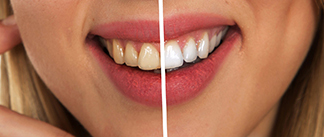Whitening Teeth For A Brighter Smile
People want whiter teeth and brighter smiles. This trend is evident with the growing number of whitening toothpastes, rinses, professional and over-the-counter systems, overnight kits and advertisements for teeth whitening. Having whiter teeth is associated with beauty, a healthy lifestyle and increased confidence. Talk to a dental hygienist about the different whitening options, what they do, and how to use them.
WHAT YOU SHOULD KNOW
- Tooth whitening is only effective in removing stains
on natural teeth. Existing crowns, bonding, bridges,
fillings or other artificial dental work will not respond
to whitening agents.
- Strips do not whiten entire arches. Generally, they
only cover the front teeth.
- Whitening may not be effective when teeth are
seriously discoloured.
- Do not smoke or chew tobacco after using
whitening products.
- Those who have tooth decay, gum disease, enamel
erosion
or hypersensitivity are advised not to use
whitening
products.
- Tooth whitening is a chemical procedure and as such
may cause some temporary reactions, such as sore
gums or teeth, which usually resolve when treatment
is discontinued.
CAUSES FOR TEETH TO BECOME STAINED
- Age
- Tobacco smoking or chewing
- Coffee, tea and red wine
- Antibiotics, such as tetracycline
- Dental fluorosis - swallowing too much fluoride
WHITENING TREATMENTS
The treatments and their effectiveness vary depending on the type of whitening system. Individuals should know the condition of their teeth and oral tissues. A thorough examination and cleaning from a dental professional is recommended before using whitening products.
Whitening toothpastes
Although some toothpastes claim to remove surface stains, it would take a long time to see any real effect of a whitening toothpaste because chemicals are only in contact with the teeth for a short period of time and they are diluted with saliva and water.
Home kits
Most home kits produce modest results at best. There are many ways to whiten teeth using self-application whitening kits, including strips, gels and even tray-based systems. All of these methods will whiten enamel somewhat, but, if applied improperly or too often, they could also irritate the gums and erode tooth enamel, especially if solutions contain acid. It is important to read the label and follow instructions carefully.
Professional whitening
Dental professionals apply a stronger solution of hydrogen peroxide than home whitening kits, and sometimes may use a special light to hasten tooth whitening. A customized mouthguard will help protect the gums. This is probably the safest and most effective way to whiten. Lasers are sometimes used to enhance the action of whitening agents. Professional whitening is more expensive than over-the-counter products and systems. According to clinical studies, 96 per cent of those who used whitening products to remove tobacco and beverage stains experienced some lightening effect. For other types of stains,
such as those produced by tetracycline or too much fluoride (fluorosis), the response to whitening was less reliable.
Does the effect last?
The whiter gleam will start to fade within a month, even sooner depending on factors such as coffee/red wine consumption or eating food that stains teeth. Smokers will quickly lose the nicer colour in their teeth.
RISK FACTORS
Whitening may temporarily increase tooth sensitivity and irritate the gums. Because of this and other potential risks, people with very sensitive teeth or gum disease, cavities or worn tooth enamel should not whiten their teeth. People with grayish discolourations, prior bonding or certain types of fillings in their front teeth are not good candidates for whitening. Cavities should be filled before whitening. Otherwise, the whitener can penetrate cavities and cause pain. Tooth whitening products are not recommended for people with peroxide allergy, pregnant women or women who are breast feeding. Since children have more sensitive teeth than adults, they should not Consider whitening until the tooth pulp is fully formed. Consult with a dental professional.
In addition, individuals may experience:
- Tissue irritation as a result of ill-fitting trays and/or
chemical sensitivity.
- Receding gums.
- Damage to restorations.
- Sensitivity to hot and cold due to high
concentrations of hydrogen peroxide.
- Sore gums from improper application or overuse of
product.
- Tooth enamel erosion from using too much over-the-
counter home whitening products, especially
those that contain acid.
- With long-term use of whitening products, natural
teeth that are close to a silver (amalgam) filling may
take on a greenish tinge.
- Allergic reaction to the product's chemical solution.
TIPS FOR SAFE WHITENING
- Clean whitening trays with a toothbrush and cold
water.
- Keep trays in the tray holder and store in a cool, dry
place away from heat and direct sunlight.
- Whitening gels can be refrigerated (not frozen) for
long-term storage.
- Read and follow the individual manufacturers'
instructions.
- If significant tooth sensitivity or gum irritations
develop, reduce application to every other day. Stop
using the product if problems persist.
- If teeth are sensitive after whitening, use a fluoride based
gel or toothpaste for sensitive teeth.
- Do not swallow plastic strips.
- Whitening gel can cause skin irritation. Wash hands
with soap and water after applying whitening strips.
- Do not get gel in the eyes.
- Do not eat, drink, smoke or sleep while
wearing a whitening strip.
- Keep whitening gel
away from leather
and fabrics.
Source: Ontario Dental Hygenists Association
Please contact us with any of your teeth whitening questions!
|
|
|

